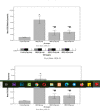Protective Effects of Quercetin and Melatonin on Indomethacin Induced Gastric Ulcers in Rats
- PMID: 33649721
- PMCID: PMC7816780
- DOI: 10.29252/rbmb.9.3.278
Protective Effects of Quercetin and Melatonin on Indomethacin Induced Gastric Ulcers in Rats
Abstract
Background: Medications to prevent the development of NSAID-induced gastric ulcers have a large range of unpleasant side effects. Recent efforts have been focused on determining safer alternative nontoxic and natural forms of anti-ulcer treatments.
Methods: Twenty-four male rats were divided into 4 groups: 1: control group that received no treatment; 2: the ndomethacin-treated group that received 20 mg/kg of indomethacin for 2 days to induce the development of gastric ulcers; 3: quercetin-treated group that in addition to the indomethacin treatment, received 50 mg/kg of quercetin 6 hours after and then daily for 14 days and; 4: the melatonin-treated group which received 20 mg/kg of melatonin 6 hours after each indomethacin treatment and then daily for 14 days. All drugs were administered orally. The following parameters were assessed in each group: mean ulcer index of gastric tissue, gastric acid volume and pH, oxidative stress markers: malondialdehyde (MDA), superoxide dismutase (SOD), glutathione peroxidase (GSH), inflammatory markers: PGE-2, TNF-α, and IL-10, nitric oxide (NO) levels and the relative gene expression of BAX, BCL-2 and COX-2 by real time PCR.
Results: Our findings revealed that the indomethacin-treated group had a significantly increased (p< 0.05) ulcer index, gastric acid volume, and elevated levels of stress, inflammatory, and apoptotic markers compared to controls. In the groups that received quercetin or melatonin, these factors were all significantly decreased (p< 0.05). Between quercetin and melatonin, there was no significant difference in their gastroprotective effect.
Conclusion: Both quercetin and melatonin had protective antioxidant, anti-inflammatory and antiapoptotic activity against indomethacin-induced gastric ulcers.
Keywords: Gastric ulcer; Indomethacin; Melatonin; Quercetin.
Figures




References
-
- Tsai TC, Brooks DC. In: (eds) The SAGES Manual of Foregut Surgery. Grams J, Perry K, Tavakkoli A, editors. Cham: Springer; 2019. pp. 635–642. Evaluation of Peptic Ulcer Disease.
-
- Jahnavi K, Pavani Reddy P, Vasudha B, Narender B. Non-steroidal antiinflammatory drugs: an overview. Journal of Drug Delivery and Therapeutics. 2014;9(1-s):442–448.
-
- Naito Y, Yoshikawa T, Wu J. Oxidative stress involvement and gene expression in indomethacin-induced gastropathy. Redox Rep. 2006;11(6):243–53. - PubMed
-
- Lichtenberger LM, Zhou Y, Dial EJ, Raphael RM. NSAID injury to the gastrointestinal tract: evidence that NSAIDs interact with phospholipids to weaken the hydrophobic surface barrier and induce the formation of unstable pores in membranes. J Pharm Pharmacol. 2006;58(11):1421–8. - PubMed
LinkOut - more resources
Full Text Sources
Research Materials
